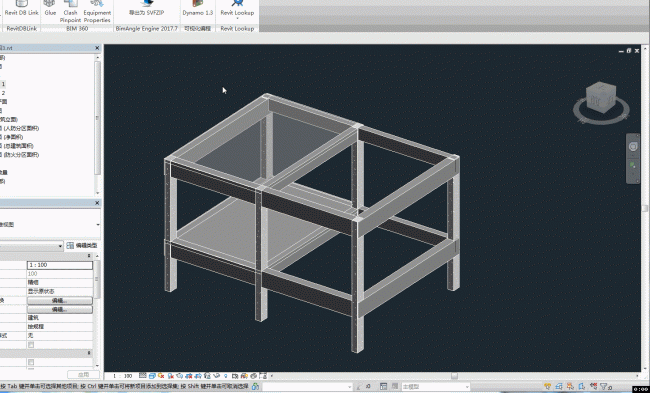Naviswork与桌子家的云浏览器都有比较友好的三维测量工具,但Revit中想在三维中测量两个物体之间的距离的时候实在是麻烦,于是想到通过二次开发来解决这个问题。
Revit的Api中有一个ReferenceIntersector类,可以在三维视图中通过一个点及一个向量找到相交的几何实体。思路上便是通过这个类实现简单的三维测量,首先需要用户点选一个实体上的点,默认的测量方向为向上,如果选择的点的主体是一个平面,则通过选择的点及平面的法向量进行测量,若果找到第二点则生成模型线并弹窗显示距离。
值得注意的有以下几个地方:
首先构造ReferenceIntersector的时候需要用一个过滤器把选择点的主体给过滤出去,要不然找到的元素就是主体本身,距离为0;
第二个要注意的就是要考虑在链接模型的图元上进行测量,因为链接模型的图元无法简单的通过Reference获取几何面,需要通过读取几何信息来获取面;
第三个就是可载入族也需要通过获取几何信息的方式来获取几何面,通过Reference获取的面会是族类型的几何面;
最后,开始我是用面的IsInside方法来判断几何实体中与点相交的面,但一些情况下会出现判断错面的问题,于是最后我是通过点到面的距离为0来取得相交面的。
以下代码:
public Result Execute(ExternalCommandData commandData, ref string message, ElementSet elements)
{
UIDocument uidoc = commandData.Application.ActiveUIDocument;
Document doc = uidoc.Document;
//选择一点
Reference ref_point = uidoc.Selection.PickObject(Autodesk.Revit.UI.Selection.ObjectType.PointOnElement);
XYZ point1 = ref_point.GlobalPoint;
//射线方向及工作平面法向量
XYZ rayDirection = XYZ.BasisZ;
XYZ skVector = XYZ.BasisX;
//当选择的主体为平面时,射线根据选择的点与此面的法线方向进行放射
if (ref_point.ElementReferenceType == ElementReferenceType.REFERENCE_TYPE_SURFACE)
{
PlanarFace pFace = null;
//主体是链接的图元时获取平面的方法
if (ref_point.LinkedElementId.IntegerValue != -1)
{
RevitLinkInstance linkIns = doc.GetElement(ref_point) as RevitLinkInstance;
Document linkDoc = linkIns.GetLinkDocument();
Element linkElem = linkDoc.GetElement(ref_point.LinkedElementId);
Options opt = new Options();
opt.DetailLevel = ViewDetailLevel.Fine;
GeometryElement geomElem = linkElem.get_Geometry(opt);
pFace = GetTarFace(geomElem, point1);
}
else
{
//判断是否FamilyInstance类型的族,采用不同的获取方法
Element elem = doc.GetElement(ref_point);
if (elem is FamilyInstance)
{
Options opt = new Options();
opt.DetailLevel = ViewDetailLevel.Fine;
GeometryElement ge = elem.get_Geometry(opt);
pFace = GetTarFace(ge, point1);
}
else
{
pFace = elem.GetGeometryObjectFromReference(ref_point) as PlanarFace;
}
}
//修正射线方向及工作平面法向量
if (pFace != null)
{
rayDirection = pFace.FaceNormal;
skVector = pFace.XVector;
}
}
//视图
View3D v3d = doc.ActiveView as View3D;
//创建射线测量出第二点
ExclusionFilter filter = new ExclusionFilter(new ElementId[] { ref_point.ElementId, ref_point.LinkedElementId });
ReferenceIntersector refIntersector = new ReferenceIntersector(filter, FindReferenceTarget.All, v3d);
refIntersector.FindReferencesInRevitLinks = true;
ReferenceWithContext rwc = refIntersector.FindNearest(point1, rayDirection);
if (rwc != null)
{
XYZ point2 = rwc.GetReference().GlobalPoint;
//创建模型线
Line line = Line.CreateBound(point1, point2);
TaskDialog.Show("距离", Math.Round(UnitUtils.ConvertFromInternalUnits(line.Length, DisplayUnitType.DUT_MILLIMETERS), 2).ToString());
using (Transaction tran = new Transaction(doc, "尺寸"))
{
tran.Start();
SketchPlane sk = SketchPlane.Create(doc, commandData.Application.Application.Create.NewPlane(skVector, point1));
ModelCurve modelCurve = doc.Create.NewModelCurve(line, sk);
tran.Commit();
}
}
else
{
TaskDialog.Show("返回结果", "未检测到图元");
}
return Result.Succeeded;
}
/// <summary>
/// 获得与UV点相交的面
/// </summary>
/// <param name="geometryElement"></param>
/// <param name="uvPoint"></param>
/// <returns></returns>
PlanarFace GetTarFace(GeometryElement geometryElement,XYZ point)
{
PlanarFace face = null;
foreach(GeometryObject geomObj in geometryElement)
{
Solid solid = geomObj as Solid;
if (solid != null && solid.Faces.Size > 0)
{
foreach(Face f in solid.Faces)
{
PlanarFace pFace = f as PlanarFace;
if (pFace != null)
{
try
{
if (Math.Round(pFace.Project(point).Distance, 2) == 0)
{
face = pFace;
break;
}
}
catch
{
continue;
}
}
}
}
if (face != null)
{
break;
}
}
if (face == null)
{
foreach(GeometryObject geomObj in geometryElement)
{
GeometryInstance geomIns = geomObj as GeometryInstance;
if (geomIns != null)
{
face = GetTarFace(geomIns.GetInstanceGeometry(), point);
}
}
}
return face;
}








评论0